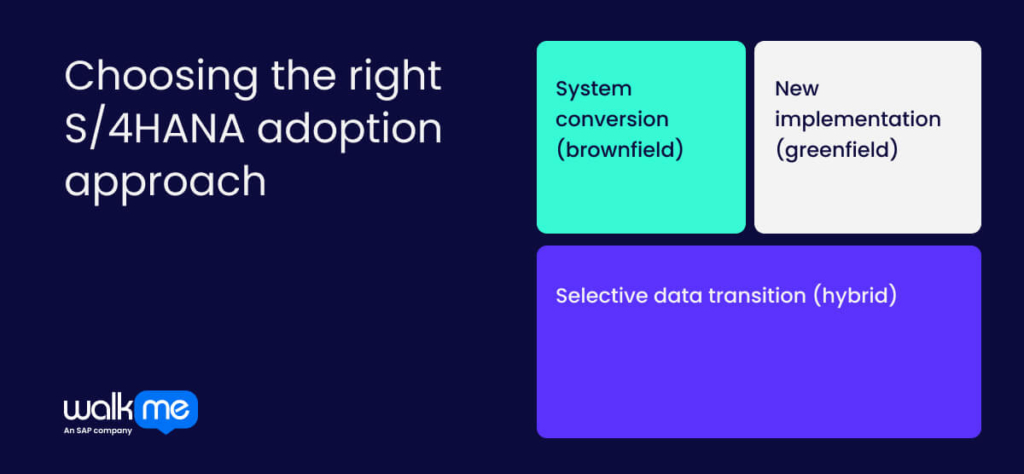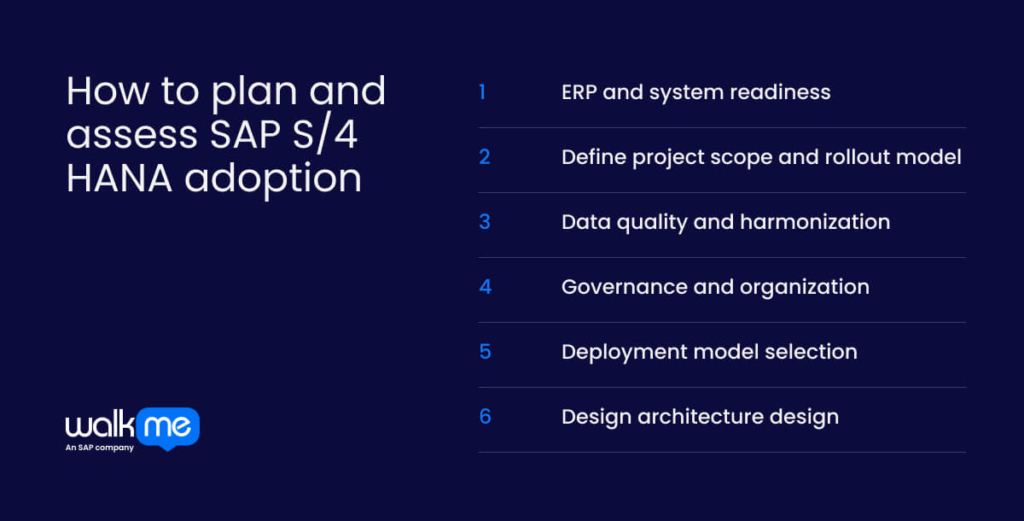Integrating enterprise resource planning (ERP) into core technology strategy supports business growth in a rapidly evolving market. ERP platforms, such as SAP S/4HANA, integrate finance, inventory, and customer service into a single system, streamlining operations and enhancing adaptability.
S/4HANA provides real-time data, a simplified architecture, and a user-friendly interface. With the right digital adoption strategy, organizations can increase agility and responsiveness.
This article outlines what SAP S/4HANA adoption entails, including how to select a practical approach and manage the complete transition.
What is a SAP S/4HANA adoption?
SAP S/4HANA adoption is the process of shifting from a legacy SAP ERP system, such as SAP ECC, to the modern S/4HANA platform. This transition introduces real-time analytics, faster transaction processing, and a simplified data model.
S/4HANA supports key business functions, including finance, HR, and supply chain management, through its in-memory architecture. Businesses utilize this platform to maintain their adaptability in their industry.
But the S/4HANA adoption process requires careful planning, especially when moving large volumes of data. Teams must clean, prepare, and transfer data without disrupting daily operations. The process also requires strong change leadership, as users often resist new systems, especially when they encounter confusing tools.
To ensure a smooth transition, organizations must build clear communication plans, involve stakeholders early, and provide ongoing user support. A digital adoption strategy helps teams unlock the full value of S/4HANA while avoiding major setbacks.
Choosing the right S/4HANA adoption approach

Opting for the right SAP S/4HANA adoption path helps ensure a better business transformation. These are the approaches to choose from:
System conversion (brownfield)
This approach upgrades an existing SAP ECC system to S/4HANA, retaining the current data, processes, and custom configurations. It’s best suited for organizations aiming to limit downtime and avoid major process changes, especially when operations are stable and continuity is a priority.
New implementation (greenfield)
A Greenfield implementation involves building a new S/4HANA system from scratch, without migrating legacy data or settings. This method allows for complete process redesign and can be rolled out all at once or in phases by business unit.
Selective data transition (hybrid)
The hybrid model combines elements of both the Greenfield and Brownfield approaches. It enables the migration of only selected data and processes, helping to reduce disruption and optimize resources by focusing on high-priority areas.
How to plan and assess SAP S/4 HANA adoption

Planning and assessment go beyond managing technical migration—they offer an opportunity to reshape core business operations. This phase lays the groundwork for long-term success by uncovering potential issues early, such as data migration challenges or integration gaps.
ERP and system readiness
Understanding the current IT landscape is an essential first step. This includes reviewing infrastructure, applications, and networks to confirm alignment with SAP S/4HANA requirements. Beyond technical compatibility, it’s essential to evaluate how S/4HANA supports broader business objectives.
Tools like SAP Readiness Check can assist by highlighting simplification items, verifying active add-ons, analyzing custom code, and evaluating the quality of financial data. These insights help organizations uncover potential roadblocks before they become issues.
Define project scope and rollout model
Clearly defined business objectives shape the scope of the S/4HANA initiative. Whether the goal is process improvement, cost reduction, or modernization, these priorities guide key decisions around module selection, integration points, and data migration.
A practical rollout plan should include a timeline, budget, resource allocation, and training considerations. Depending on organizational needs and risk tolerance, a phased rollout can reduce disruption, while a full deployment may accelerate time to value.
Data quality and harmonization
Reliable data is a prerequisite for successful adoption. Reviewing the current data landscape helps expose inaccuracies, inconsistencies, and outdated records. Cleansing, deduplication, and standardization—supported by tools such as SAP Data Services—ensure compatibility with S/4HANA.
Establishing data ownership and quality benchmarks through a governance framework supports ongoing integrity. Mapping and conversion of legacy data should follow structured rules or templates, with thorough testing throughout the migration process. SAP MDG and CDQ can support sustained quality improvement.
Governance and organization
Governance plays a critical role in aligning the transformation effort with business strategy. Integrating S/4HANA goals into governance processes helps maintain focus and accountability.
A structured change management plan, including stakeholder engagement, training, and clear communication, minimizes resistance and supports user adoption. Business continuity planning, supported by tools like SAP Model Company and preconfigured processes, further enhances resilience. Establishing a Center of Excellence (CoE) helps embed best practices and guide future innovation.
Deployment model selection
The choice between cloud, on-premise, or hybrid deployment models depends on a range of factors, including scalability, integration complexity, compliance requirements, and internal technical capabilities. Evaluating the total cost of ownership and long-term upgrade paths is equally important.
Security, regulatory compliance, and compatibility with existing systems should be confirmed as early as possible in the planning process. The selected model must also support future S/4HANA updates and evolving business needs.
Design architecture design
A scalable and secure integration strategy ensures long-term flexibility and stability. Designing architecture around specific business use cases helps prioritize what matters most. Sensitive data must be protected with strong controls, while performance should remain a consistent focus.
The SAP Integration Suite provides ready-to-use connectors, while the SAP Business Technology Platform (BTP) enables cloud-based extensions and integrations. Together, these tools support a flexible architecture that can adapt to future demands.
Executing the SAP S/4 HANA adoption project
Once planning is complete, clear and coordinated execution becomes essential. Cross-functional teams benefit from structured steps that help manage complexity, reduce risks, and ensure the business gains full value from the new system.
Leveraging the SAP Activate methodology
SAP Activate offers a guided framework for implementing SAP S/4HANA, structured around six distinct phases:
- Discover: Project goals are defined, scope is outlined, and the current IT landscape is reviewed.
- Prepare: Teams are assembled, existing processes are assessed, and a detailed implementation plan is created.
- Explore: Target processes are tested, and the initial system configuration begins.
- Realize: Final configuration is completed, integrations are built, and comprehensive testing takes place.
- Deploy: Data migration is performed, final validations are carried out, and the system goes live.
- Run: Ongoing operations are supported through performance monitoring and issue resolution.
This phased approach provides structure and transparency while supporting iterative feedback and continuous improvement.
Building, Testing, and Migrating the System
The execution phase includes setting up the system, validating its performance, and migrating essential data. System configuration is guided by the chosen deployment model and architectural design.
During this stage, organizations establish security roles, enforce segregation of duties (SoD), and create user access policies. Custom features may be developed as needed, and integrations with other systems are configured.
For data migration, it is important to identify which data types—such as master and transactional data—will be transferred. Cleansing and preparation ensure accuracy and relevance. Tools like SAP Migration Cockpit streamline the data loading process and support quality checks before and after migration.
Comprehensive testing is essential to verify functionality, performance, and integration points. Automated testing strategies can accelerate this process while helping reduce errors and project risks. Successful completion of this phase ensures the system is ready for deployment and long-term operation.
Go-live and post-adoption stabilization
Adoption does not stop with the execution of SAP S/4HANA. Clear steps for go-live and after help make S/4HANA adoption better in the long term. They support ongoing improvements and help the system grow with the business. Make these steps part of the ongoing adoption plan:
Execute cutover planning
Cutover planning plays a key role in moving from a legacy system to SAP S/4HANA. Teams must create a clear plan that outlines timelines, key tasks, and assigned roles. They should outline critical steps, such as system shutdown, system checks, and employee training. Using tools like SAP Activate and runbooks helps manage the process.
During execution, teams closely follow the plan, run final tests, and prepare for any potential issues. They reduce downtime through automation and complete a final data load before going live, ensuring a successful transition.
Hypercare and support
A strong hypercare plan helps ensure a smooth start after going live with SAP S/4HANA. The team provides support, monitors system performance, verifies data accuracy, and resolves issues promptly. They keep open communication and gather user adoption feedback to improve the system.
This team also documents common fixes and shares them with users and support teams. After hypercare, the team hands over to the regular end-user support team.
Drive user enablement
To drive the digital adoption of S/4HANA, start early and offer targeted technical training. Utilize tools like SAP Enable Now to provide in-app guidance and monitor user learning progress. Break training into short, clear lessons.
Show help inside the system when users need it. Build a team of super users who can guide others and answer questions after the main training ends. This approach helps users feel confident using the new system.
Focus on continuous optimization for successful S/4HANA adoption
Achieving long-term success with SAP S/4HANA requires ongoing refinement beyond the initial go-live. Optimization begins with reviewing system performance and addressing any outstanding data quality issues. The chosen adoption path—whether greenfield, brownfield, or hybrid—should remain aligned with evolving business goals.
Early integration planning helps prevent misalignment between systems and avoids costly adjustments later. Close coordination between business and IT teams, supported by strong governance, keeps the project on course throughout its lifecycle.
The SAP Activate methodology continues to serve as a valuable guide, offering structure and helping to maintain realistic timelines. After deployment, sustained user support and training are essential to ensure adoption and system effectiveness.
Continuous improvement—through process updates, system tuning, and strategic enhancements—allows organizations to fully leverage the capabilities of S/4HANA and stay resilient in a shifting business environment.
FAQs
Moving to SAP S/4HANA involves several key steps: assessment, planning, execution, and post-go-live support. These steps usually follow the SAP Activate method, which uses best practices, guided setup, and helpful tools.
RISE with SAP is an all-in-one subscription that includes S/4HANA Cloud, hosting, migration support, and transformation tools under a single contract. It simplifies cloud adoption and vendor management. Traditional adoption requires separate contracts for software, infrastructure, and services, offering more flexibility but involving greater complexity and coordination.

